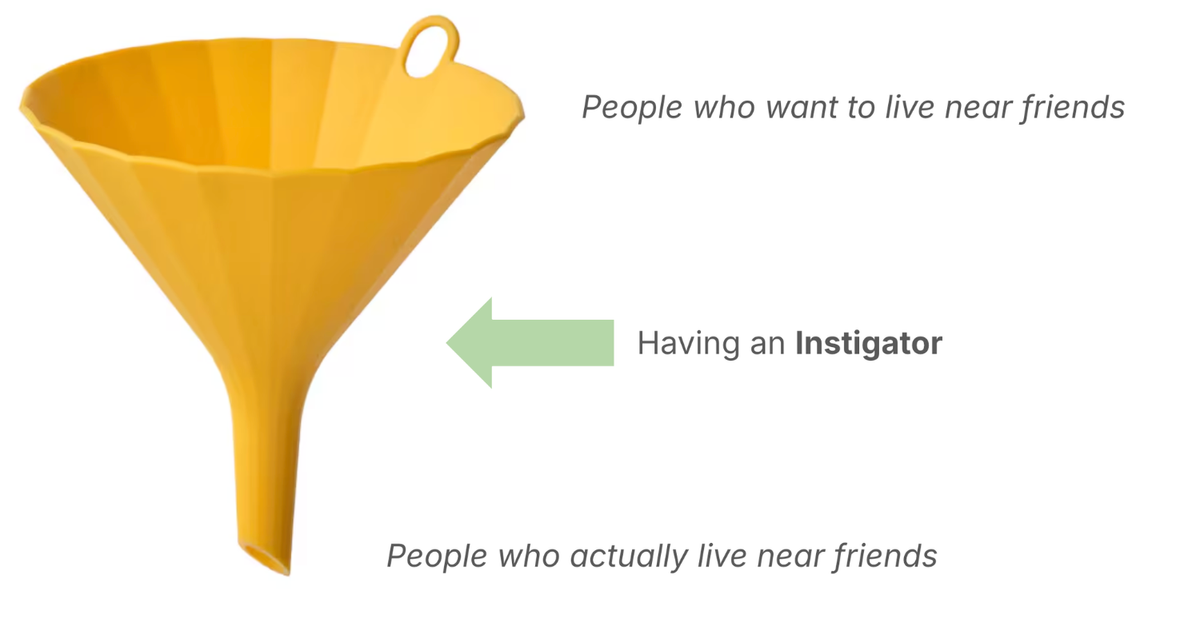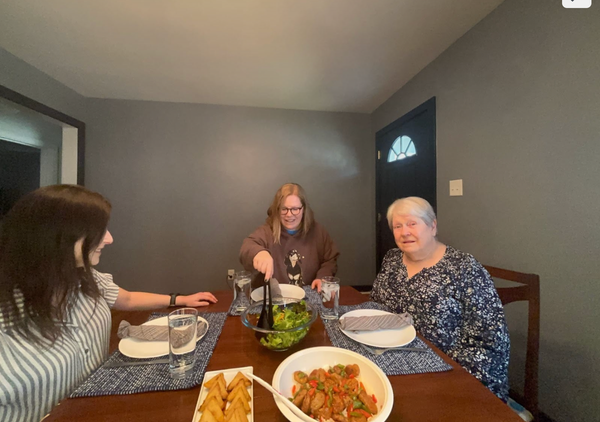Want to Live Near Friends? You'll need an Instigator

So you want to live near friends, but you’re not sure how to get everyone on the same page. This article will cover everything you need to know about assembling a group of friends, assessing fit, and getting from fuzzy to firm commitment. The advice here applies to any type of live-near-friends configuration: renters or buyers, small groups or large.
STEP 1: Step into your role as “The Instigator”
Many people dream of living near their friends, but few actually make it happen.

The key factor in most success stories is the presence of an “Instigator”—someone who decides to take the lead and says, “I’m going to make this happen” for themselves and their friends.
So who is The Instigator in your group?
Chances are, if you are reading this, that person is probably YOU.
The Instigator is the person who makes the ask.
And if no one makes the ask, you know exactly what’s going to happen. Everyone will make individually optimal decisions that are suboptimal for the whole.
- Without making the ask, one friend will move to the suburbs for a yard—not realizing they can have a bigger yard living with you. And that window of opportunity will close.
- Without making the ask, another friend will move to Sacramento because it’s a bit cheaper—not realizing they could get more for less living with you. And that window of opportunity will close.
- Without making the ask, another friend will move near their family for childcare—not realizing that you can help take care of their child. And that window of opportunity will close.
Before you know it, everyone is locked into their mortgages and elementary schools and living near friends is a nice idea you all shared in your early 30s, not a practical reality that makes adult life better for the long haul.
The solution to this is coordination, and to coordinate, you need a coordinator. That’s you.
It might feel a little uncomfortable to step into this role. It’s a little like organizing a bachelor party or a ski trip: sometimes you have to pester people a bit to make it happen. But don’t let that stop you, because the end result is completely worth it.
STEP 2: Socialize the idea with your friends
This is where you “come out” to your friends about your desire to live near each other.
Why do you want to do this? When Phil wanted to start Radish, he wrote a rallying cry that outlined his vision and called for others to join him. You don’t need to come up with some grand vision, but it’s helpful to articulate your “why”, even if it’s just a bullet point or two.

Now you have something to share with your friends. You can do this in whatever way is comfortable for your friend group, whether that’s casual conversations over coffee, a discussion over dinner, or a simple text message.
The point is to make it clear that you’re excited (and serious!) about this idea, and to check if your friends feel similarly.
How many friends should you bring into the conversation at this point? That depends in part on the scale of the project you have in mind, but generally we recommend 2 - 3x the number of people you ultimately want to live near: if you want to live in a duplex, discuss it with two or three friends. For a triplex, four to six. The stars are not always going to align for a specific person, so having a pool of people is a better way to ensure you make it happen.
STEP 3: Finalize your group - The two C's
Your next step is to go through a process to narrow down the group to a final set of committed participants. What you are trying to do here is assess the two big “C’s”: commitment and compatibility.
You can start small and work your way up. Some ideas:
- Co-host a monthly dinner for your friend group
- Take a weekend trip together
- Take a 1-2 week vacation together
- If you can manage the logistics, try living together for a month
Throughout these steps, pay attention both to what it feels like to plan something together and what it feels like to spend lots of time with each other. How well do you communicate? What do you do when you need space? How do you handle disagreements? Most importantly, are you having fun, and wishing you could have more of this in your life?
Up until now, you might have only been discussing the idea of living near each other. That’s easy to get on board with—it’s all unicorns and rainbows. But how do your friends feel about a real-life setup in a specific location, with all the trade-offs that come with it (and the work needed to find it)?
Find a property listing that’s similar to what you might be looking for and calculate what everyone’s potential share might be, whether that’s monthly rent or potential down payment, mortgage, insurance, and maintenance expenses. Put those numbers in front of your friends and ask if they feel comfortable with it and still want to move forward. Make them sit with good, bad, and ugly of the housing trade-offs in your city.
If they do, great! The next step in assessing commitment is to see whether they’re willing to invest time and money to make this a reality. You can invite them to undertake a series of escalating steps towards making it happen. This can include things like:
- Filling out a survey about their housing preferences (more on this below)
- Taking a weekend to tour properties together
- Getting pre-approved for a loan, either separately or together (if buying)
- Contributing a few hundred dollars to a housing search fund (to cover potential search costs such as sharing an uber to see a house, hiring an architect to look at it with you, consulting with a lawyer about a contract, etc)
Finding a new place to live is definitely going to involve the investment of everyone’s time and money, and the friends who demonstrate their willingness to contribute those things throughout the process will make the best partners.
What if you end up with too many people?
Now, suppose you set out to buy a duplex but you end up with two other interested parties instead of one. This isn’t the worst problem to have. Can you consider a triplex?
If that’s not an option, you can come up with more escalating commitments to assess which friends are most enthusiastic, compatible, and committed. Or split into two groups and try to find two properties near each other.
Questions you might ask your friends to assess fit
When would you want to do this? (next 3 months, next year, sometime in future)
When does your current lease end?
What’s your budget?
Do you want to buy or rent?
How much space do you need?
How fancy is your ideal place? (use the Yelp scale: $ - $$$$)
Any location must haves / deal breakers? (specific neighborhoods, distance to transit, etc)
Any amenity must haves / deal breakers? (outdoor space, parking, number of bathrooms, etc)
If we bought a place together, how long would you ideally want to live there?
What form factors do you like? (diagram below might be helpful)

How many other households do you want to live with?
If we bought a place together, how long would you ideally want to live there?





